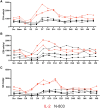Safety and Virologic Impact of Haploidentical NK Cells Plus Interleukin 2 or N-803 in HIV Infection
- PMID: 38207119
- PMCID: PMC11095546
- DOI: 10.1093/infdis/jiad578
Safety and Virologic Impact of Haploidentical NK Cells Plus Interleukin 2 or N-803 in HIV Infection
Abstract
Background: Natural killer (NK) cells are dysfunctional in chronic human immunodeficiency virus (HIV) infection as they are not able to clear virus. We hypothesized that an infusion of NK cells, supported by interleukin 2 (IL-2) or IL-15, could decrease virus-producing cells in the lymphatic tissues.
Methods: We conducted a phase 1 pilot study in 6 persons with HIV (PWH), where a single infusion of haploidentical related donor NK cells was given plus either IL-2 or N-803 (an IL-15 superagonist).
Results: The approach was well tolerated with no unexpected adverse events. We did not pretreat recipients with cyclophosphamide or fludarabine to "make immunologic space," reasoning that PWH on stable antiretroviral treatment remain T-cell depleted in lymphatic tissues. We found donor cells remained detectable in blood for up to 8 days (similar to what is seen in cancer pretreatment with lymphodepleting chemotherapy) and in the lymph nodes and rectum up to 28 days. There was a moderate decrease in the frequency of viral RNA-positive cells in lymph nodes.
Conclusions: There was a moderate decrease in HIV-producing cells in lymph nodes. Further studies are warranted to determine the impact of healthy NK cells on HIV reservoirs and if restoring NK-cell function could be part of an HIV cure strategy. Clinical Trials Registration. NCT03346499 and NCT03899480.
Keywords: HIV; IL-15; IL-2; N-803; NK cells; reservoir.
© The Author(s) 2024. Published by Oxford University Press on behalf of Infectious Diseases Society of America. All rights reserved. For permissions, please e-mail: journals.permissions@oup.com.
Conflict of interest statement
Potential conflicts of interest. J. T. S. and P. S. S. are affiliated with ImmunityBio, which provided N-803 for the trial. Neither of these authors had any influence on study design or data interpretation. All other authors report no potential conflicts. All authors have submitted the ICMJE Form for Disclosure of Potential Conflicts of Interest. Conflicts that the editors consider relevant to the content of the manuscript have been disclosed.
Figures





Comment in
-
Allogeneic Natural Killer Cells: An Additional Player in Human Immunodeficiency Virus Cure Approaches?J Infect Dis. 2024 May 15;229(5):1249-1251. doi: 10.1093/infdis/jiae005. J Infect Dis. 2024. PMID: 38206191 No abstract available.
References
-
- Finzi D, Blankson J, Siliciano JD, et al. Latent infection of CD4+ T cells provides a mechanism for lifelong persistence of HIV-1, even in patients on effective combination therapy. Nat Med 1999; 5:512–7. - PubMed
Publication types
MeSH terms
Associated data
Grants and funding
LinkOut - more resources
Full Text Sources
Medical

